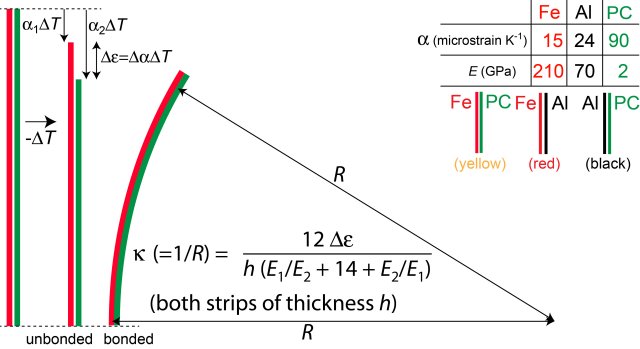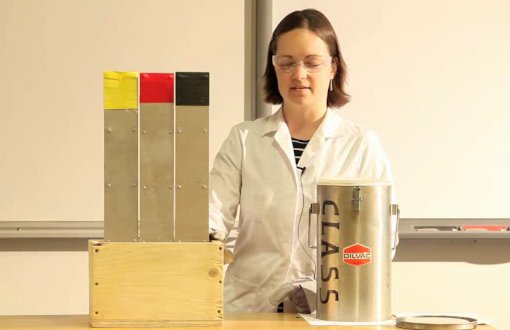Cooling of bi-material strips to generate curvature (all content)
Note: DoITPoMS Teaching and Learning Packages are intended to be used interactively at a computer! This print-friendly version of the LDP is provided for convenience, but does not display all the content of the LDP. For example, any video clips and answers to questions are missing. The formatting (page breaks, etc) of the printed version is unpredictable and highly dependent on your browser.
Contents
Introduction
The package provides information needed to set up and present a short practical demonstration in a lecture. This LDP (Lecture Demonstration Package) is centred on how is cooling of bi-material strips to generate curvature. The relationship between the curvature of a bi-material strip, the stiffness and thermal expansivities of the materials from which it is made, and the temperature change undergone is examined. The boiling temperature of nitrogen is then estimated by using this relationship and measuring the change in shape of a bi-material strip made from materials (steel and aluminium, aluminium and a polybicarbonate, steel and a polybicarbonate) of known thermal expansivities.
Young's Moduli and thermal expansivities of various types of material
_T_schem_s.jpg)
As shown in the figure, the Lennard-Jones potential is normally asymmetric, so that increases in temperature (ie in the amplitude of oscillation of atoms) lead to an increase in the average inter-atomic separation, and hence to (thermal) expansion. The stiffness (Young's modulus), on the other hand, depends on the restoring force when atoms are forced apart (or together), which is the gradient of the plot. Materials with strong inter-atomic forces (deep potential wells), such as ceramics, therefore tend to have low thermal expansion coefficients (expansivities) and high stiffness. In contrast, polymers, which in general have weak inter-atomic forces, tend to have high expansivities and low stiffness. Metals are usually intermediate between these two cases.
Curvature generation on changing the temperature of a bi-material strip

The above figure shows a schematic illustration of how curvature arises on changing the temperature of a bi-material strip. Also shown is the equation giving the resultant curvature for the case of both strips being of equal thickness (h). (The derivation of this equation, and also the corresponding equation for the case of unequal strip thicknesses, is given in the following paper: Clyne, TW, Key Engineering Materials, vols.116-117 (1996) p.307-330.)
IT resources - simulation of curvature generation
This simulation gives a visual representation of how curvature arises on changing the temperature for a given bi-material strip (with both constituents having the same thickness). It is based on the equation presented in the previous page. There are two modes of operation - one reflecting the cases of the three strips used in the demonstration and the other "customised" - ie allowing any material properties to be selected and the thickness to be chosen as one of three available values. In both modes, the temperature is changed via the slider bar.
Equipment and facilities needed for the demonstration

The equipment required is simple, although clearly the experiment does need a fair amount of preparation - at least the first time it is carried out! It's important that there should not be any significant leakage from the box. A simple wooden construction should be adequate, provided the jointing is good. Clearly it would also be possible to make it of metal (although it's worth noting that there may then be a greater danger than is the case with a wooden box of acquiring a "burn" from it via contact with unprotected skin while cold). A plastic construction would also be possible, particularly if a moulded box with suitable dimensions could be found. (Some plastics, however, become very brittle at liquid nitrogen temperatures.) The (external) dimensions of the box used are 300 mm long by 190 mm deep by 150 mm wide, although clearly none of these dimensions are critical. They just need to be suitable to accommodate the strips, which in this case were about 70 mm wide by 500 mm long, and also to hold a suitable depth of liquid nitrogen.
It's best for the strips to be fairly long, so that the behaviour can clearly be seen by the audience, although it's perhaps worth noting that, depending on the depth of the liquid nitrogen, it may be that the full length of the strips do not cool down significantly. The uncooled parts help to illustrate the behaviour, even if they do not have the correct, or any, curvature. Another practical point to note is that if the box is large in section then it may require quite a lot of liquid nitrogen to fill it to a suitable depth. The capacity of the box used in the demonstration shown is about 4 litres, which is probably about as much liquid nitrogen as can conveniently be handled in a lecture theatre.
Each of the individual strips used is 1 mm in thickness. Sheet material with this thickness is in general easily obtainable. Thinner sheet could be used, and would lead to higher curvatures, but there might be a danger of plastic deformation arising, particularly with the aluminium, and this would cause some problems. Thicker sheet, on the other hand, will reduce the curvature and make the deflections less noticeable. Some attention should also be paid to the joining of the pairs of strips. Adhesive joining could be attempted, but it should be noted that substantial shear forces are generated during cooling, plus the adhesive is likely to become brittle at low temperature. The upshot of this is that debonding is likely to occur, even if the bonding process is carried out very carefully. The best solution is probably to use rivets. A set of about half a dozen down each side should be adequate. Rivets can be used in combination with adhesive bonding.
It may add to the interest level if the audience are asked beforehand to nominate which of the three bi-material strips will give the largest curvature. Identifying the correct answer (the Al-PC combination) does require an appreciation that both a large difference in expansivity and a small ratio between the two stiffnesses will favour a high curvature. Probably most of the audience will be unlikely to spot this immediately, and so the outcome may be a surprise to them.
There are, of course, some safety issues and a risk assessment form should be completed. It's certainly a good idea to practice the demonstration beforehand, in the location concerned. A lab-coat, goggles and gloves should be worn. However, minor spills of liquid nitrogen are unlikely to cause any major hazards and in general this is expected to be a safe and straightforward experiment to carry out.
Video of the demonstration
Academic consultant: (University of Cambridge)
Content development: Denis Lomakin
Photography and video: Steve Penney, Jess Gwynne
Web development: Lianne Sallows and David Brook
This DoITPoMS LDP was funded by the UK Centre for Materials Education and the Department of Materials Science and Metallurgy, University of Cambridge.

